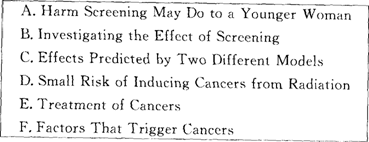 题目内容
(请给出正确答案)
题目内容
(请给出正确答案)
Screen Test1. Every year millions of women are screened with X-rays to pick up signs of br
Screen Test
1. Every year millions of women are screened with X-rays to pick up signs of breast cancer. If this happens early enough, the disease can often be. treated successfully. According to a survey published last year, 21 countries have screening programmes. Nine of them, including Australia, Canada, the US and Spain, screen women under 50.
2. But the medical benefits of screening these younger women are controversial, partly because the radiation brings a small risk of inducing cancer. Also, younger women must be given higher doses of X-rays because their breast tissue is denser.
3. Researchers at the Polytechnic University of Valencia analysed the effect of screening more than 160,000 women at 11 local clinics. After estimating the women's cumulative dose of radiation, they used two models to calculate the number of extra cancers this would cause.
4. The mathematical model recommended by Britain's National Radiological Protection Board (NRPB) predicted that the screening programme would cause 36 cancers per 100,000 women, 18 of them fatal. The model preferred by the UN Scientific Committee on the Effects of Atomic Radiation led to a lower figure of 20 cancers.
5. The researchers argue that the level of radiation-induced cancers is "not very significant" compared to the far larger number of cancers that are discovered and treated. The Valencia programme, they say, detects between 300 and 450 cases of breast cancer in every 100,000 women screened.
6. But they point out that the risk of women contracting cancer from radiation could be reduced by between 40 and 80 percent if screening began at 50 instead of 45, because they would be exposed to less radiation. The results of their study, they suggest, could help "optimise the technique" for breast cancer screening.
7. "There is a trade-off between the diagnostic benefits of breast screening and its risks," admits Michael Clark of the NRPB. But he warns that the study should be interpreted with caution. "On the basis of the current data, for every 10 cancers successfully detected and prevented there is a risk of causing one later in life. That's why radiation exposure should be minimized in any screening programme."
A. Risk of Screening to Younger Women
B. Investigating the Effect of Screening
C. Effects Predicted by Two Different Models
D. Treatment of Cancers
E. Minimizing of Radiation Exposure
F. Factors That Trigger Cancers
Paragraph 2______
 答案
答案


























